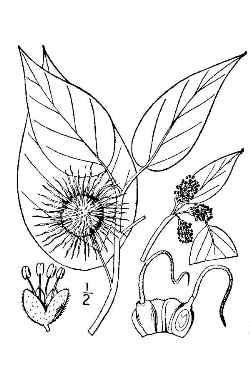
Britton, N.L., and A. Brown. 1913. Illustrated flora of the northern states and Canada. Vol. 1: 632. Courtesy of Kentucky Native Plant Society
Sunset®: All zones
USDA: 4-10
Heat Tolerance: Little to occasional water in the low deserts
Sun Exposure: Full sun
Origin: USA (Texas, Louisiana, Oklahoma, Arkansas)
Growth Habits: Small deciduous tree, about 30-60 feet tall (9-18 m); inner bark is orange; sap is milky; stout thorns 0.5 to 1 inch long (1.3-2.5 cm); bright green leaves 2 to 5 inches long (5-12 cm); tap root
Flowers: Greenish flowers
Watering Needs: Little to no water
Propagation: Seeds, softwood cuttings, root cuttings
Some varieties are being selected with less thorns. Selected trees are propagated from male trees and have no fruit.
Blooming Habits:
Dioecious, inconspicuous flowers from April to June
Fruiting Habits:
Females osage orange tree have large, round inedible fruits (hedge-apple), 4 inches in diameter (10 cm), ripens from September to October. The fruit is composed of many fleshy calyces, each containing one seed.
Desert-Tropicals is dedicated to provide gardening advice, gardening ideas, and information about flower of all kind for landscape and collections.We try to check carefully the identification of the plants on the illustrations as well as the other information from the page, but occasionally errors do occur. if you notice anything that needs to be changed please contact us.Thanks.
© 1998-2020 Philippe Faucon, All Rights Reserved.